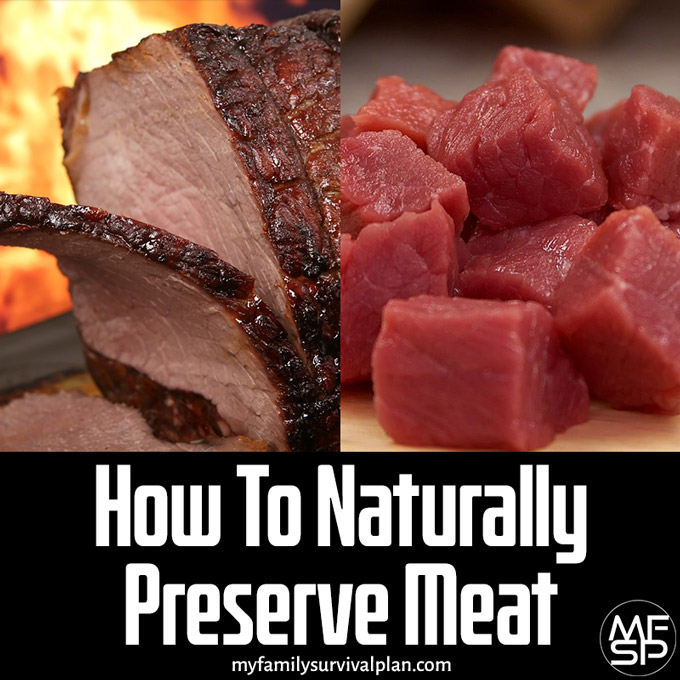Click Here To Join Our Telegram Channel for FREE daily tutorials!

How To Naturally Preserve Meat. Photos – Pixabay (PD)
In a survival scenario, learning how to store food will once again be crucial for your very own existence – like the good old days. Your fridge will probably become just another shelf, useless without a power source. But there are ways to still keep your balanced diet, ways that help you preserve and store even the most important food group: meat!
Even if you survived the “fall of mankind”, doesn’t mean you have to give up on eating healthy. And by smoking and curing your meats, you’ll still be able to enjoy roast beef or bacon. I’ll walk you through the easy steps of keeping your meats fresh and tasty without a fridge.
How To Smoke Your Meat
The process of smoking food is defined by exposing the meat (of almost any sort) to the smoke produced by burning plants, smoldering wood or other spices or organic materials. In the U.S. the most commonly used smoking woods are apple, cherry, oak, and mesquite. The meat is smoked for long periods of time at low temperatures (180° – 225°F), reliant on indirect heat. Grilling is a similar process, but it’s based direct heat and high temperatures. The practice of smoking began purely out of necessity. Before modern day appliances, smoking was an excellent means of preserving meat because the smoke covers the surface like an acidic coating, a very inhospitable surface for bacterial agents. Furthermore, it also dehydrates the meat, furthering, even more, its resistance. Today, meat is smoked or cured purely for flavouring reasons, as modern means of conservation are preferred. But the way things are looking, we’re about to go back to old habits rather sooner than later.
Smokers today use all sorts of devices, based on different types of energy: propane, electricity, charcoal, and pretty much everything else capable of generating smoke. Some backyard kettle grills can be easily modified to become instant smoking apparatuses. But there are also professional smoking machines available on the market. Just make sure you have enough space for such an appliance before purchasing one.
There are 2 basic ways in which you can smoke your meats:
Cold smoking is used for flavouring rather than cooking. The process involves temperatures of less than 100°F and longer periods of exposure to smoke. It’s an excellent method of adding taste to already cured fish without actually cooking it. The same goes salami and other sorts of meat.
Hot smoking is different; it should be done in a closed appliance (be it grill or any sort for cooking gadget) so that the meat is not only being flavoured by the smoke but also cooked by the generated heat. The temperatures, in this case, are considerably higher (140°F – 160°F). For safety, the meat should be cooked at first at 160°F for 45 minutes straight, to ensure the annihilation of any sort of parasites or bacterial agents.
Different types of wood give different results when it comes to smoking meat. Hardwood and fruitwood make for excellent savoury smoke, mesquite smoke gives an earthy flavour, fresh apple wood smoke is sweet and goes great with poultry and pork and hickory wood gives the meat a sharp and rich flavour. If you plan on gathering smoking wood, make sure not to gather any sort of toxic or poisonous plants.
How To Cure Your Meat
Curing basically means preserving meat and fish in salt. Back in the days when refrigerators or refrigeration techniques hadn’t been discovered yet, curing with salt was the only way to maintain freshness. The abundance of salt created a more than the inhospitable place for bacteria that, if left alone, would spoil and rot the meat in no time. But because due to modern day technological advances, curing (like smoking), it’s no longer used for preservation purposes, but only for flavoring. The process of curing doesn’t normally rely on salt alone. It’s more than common to use other ingredients to contrast the salt. Sugar (brown sugar, honey, maple syrup) it’s the best counter for salt and adds a unique flavor. There other frequently used herbs or spices as well: black pepper, coriander, bay leaves and more.
There is another important ingredient which you can’t do without, and it’s more than add flavor. Sodium nitrite (commonly found in spinach, lettuce and celery) it’s very important to the mix, because it inhibits the growth of the Botulism bacteria, which can be fatal.
Sodium nitrite will also give a specific savor and a unique color (bright red). This ingredient, however, can be toxic in high dosage, so respect the following mixture recommendations: 6.25% sodium nitrite to 93.75% table salt (regardless if you’re using pink salt or fresh vegetable extracts as a source of nitrites).
Once you have everything ready, you can cut your meat into slabs. Afterwards cover each slab heavily with the salt mixture. After you’re done, pack the meat slabs tightly in jars and place them in storage space of your choice, where the temperature should ideally be around 36°F. Let the meat sit for a month, and afterwards take it out and wrap each slab in paper or plastic, making sure each one is airtight, so moisture doesn’t get in. The meat slabs can be stored again or consumed at your own will.
How To Brine Your Meat
The process of meat brining is also known as “wet curing”. It goes by the same principle of meat preservation with salt. But rather than relying on dry salt, brining is about keeping the meat submerged in a saline solution. The meat needs to be cut in slabs and placed into jars or containers that have been previously washed and sanitized. One way of preparing the saltwater is by adding 1 pond salt + 1 cup sugar / 3 quarters of water. Spices and herbs can be added as well, according to taste. The meat should stay completely submerged in the saline solution. Once the meat is placed in storage you’ll have to check on it once a week, stir the brine or replace it if it thickens. The process will last a month.
These are some of the cheapest, easiest and most practical methods of naturally preserving meat. Each one is different and comes with its own unique flavor, so you should try them all out before deciding what works best for you. So get practicing while it’s still all in good fun rather than for survival reasons.
Image For Pinterest:

Graphic – www.myfamilysurvivalplan.com. Images – Pixabay (PD)
This Crazy Off Grid Device Literally Makes Drinkable Water From Fresh Air:
According to NASA, the U.S. is expecting a 100-YEAR LONG MEGADROUGHT.
It's already begun. Ask the farmers in California. They know.
Every survivalist knows that water is of critical importance. You NEED an independent water source that you can count on!
As an interesting "survival rehearsal" - imagine that you turned the tap on right now and nothing came out. How long would you last?
But what if there was another water source literally hidden in plain sight. That's right, I'm talking about the atmosphere!
The amazing thing about getting water from the natural moisture in the air... is that it is ALWAYS available.
This gives you real water security!
Learn more about how to tap into "Nature's secret water reservoir" and stay hydrated when TSHTF!
Watch the video:
😳 What Tinnitus Does To Your Brain Cells (And How To Stop It)
After 47 years of studies and countless brain scans done on more than 2,400 tinnitus patients, scientists at the MIT Institute found that in a shocking 96% of cases, tinnitus was actually shrinking their brain cells.
As it turns out, tinnitus and brain health are strongly linked.
Even more interesting: The reason why top army officials are not deaf after decades of hearing machine guns, bombs going off and helicopter noises…
Is because they are using something called "the wire method", a simple protocol inspired by a classified surgery on deaf people from the 1950s...

I Can't Help Showing This Off:
If you haven't heard of Claude Davis yet do yourself a huge favor and watch this video.
One of the smartest guys I ever had the pleasure of meeting, Claude set-up a unique prepping system that changed his life forever.
I already tried it myself and let me tell... you I was completely blown away... His surprising tactics could make your life easier and give you the peace of mind you deserve.
Don't just take my word for it... watch his short video and decide for yourself.

Most People Don't Have The Guts To Try This:
An amazing discovery in an abandoned house in Austin, Texas: A lost book of amazing survival knowledge, believed to have been long vanished to history, has been found in a dusty drawer in the house which belonged to a guy named Claude Davis.
Remember... back in those days, there was no electricity... no refrigerators... no law enforcement... and certainly no grocery store or supermarkets... Some of these exceptional skills are hundreds of years of old and they were learned the hard way by the early pioneers.
>> Click here to find out about them now
We've lost to history so much survival knowledge that we've become clueless compared to what our great grandfathers did or built on a daily basis to sustain their families.
Neighbors said that for the last couple of years Claude has tried to unearth and learn the forgotten ways of our great-grandparents and claimed to have found a secret of gargantuan proportions. A secret that he is about to reveal together with 3 old teachings that will change everything you think you know about preparedness:
>>> Click Here To Watch His Short Video <<<

More Off-Grid And Survival Resources:

What REALLY Happens When You Bury a Shipping Container? (Hint: It's A Bit Crazy...)
Shipping containers are all the rage - but if you are thinking about buying one, you MUST watch this video first:
There's a general belief that if you bury a shipping container you can create an awesome root cellar / storm shelter / survival bunker.
But is a shipping container strong enough to handle the pressure?
Watch the video to see what happens:
What Really Happens When You Bury a Shipping Container? (Click To Watch Video)














Truly outstanding article. One that will go a long way to carry us through the hard times. Tomorrow when I have more time I’m going to try and print this article for future reference. Thanks a million for a job well done.
I was wondering if there was going be a part 2 of the pastrami (preserving meat) or have I missed it?
Lots of good stuff in here, keep up the good work.